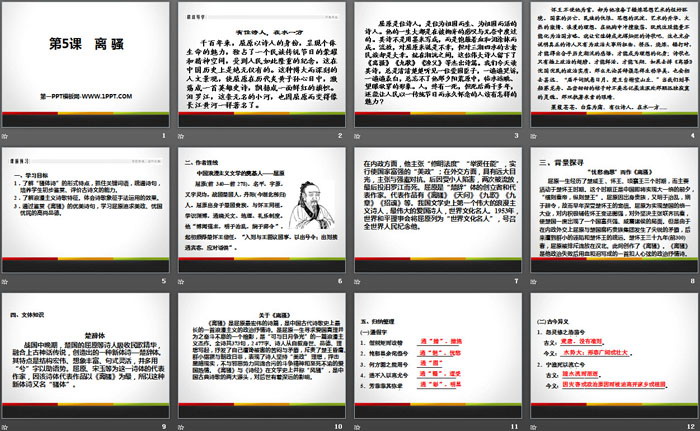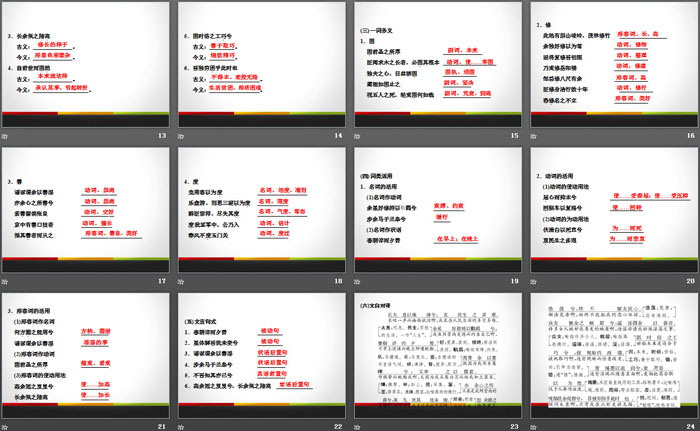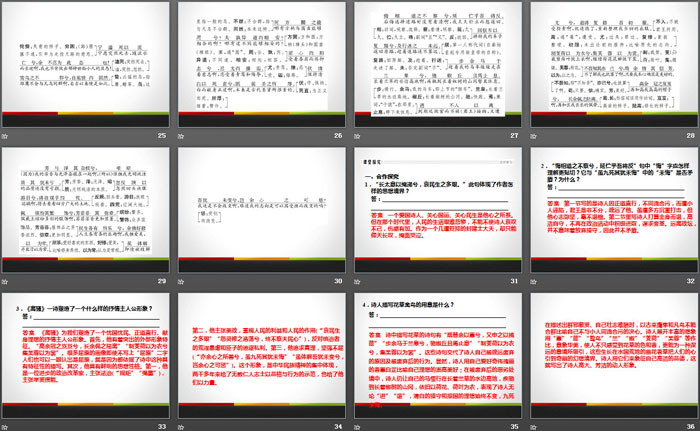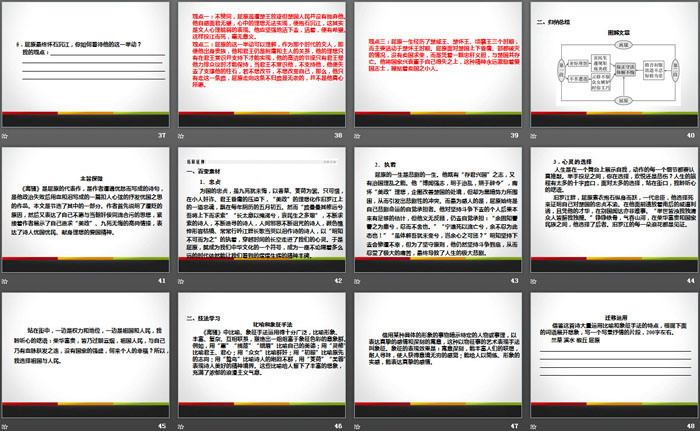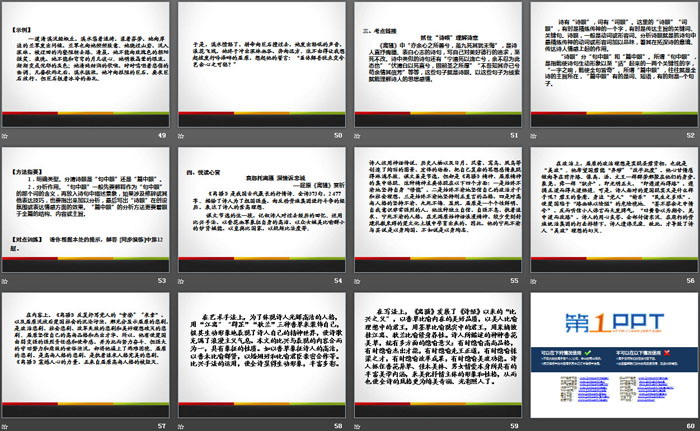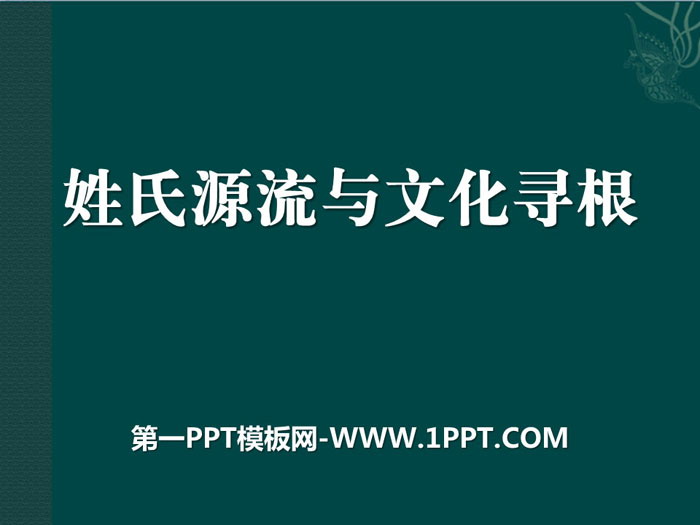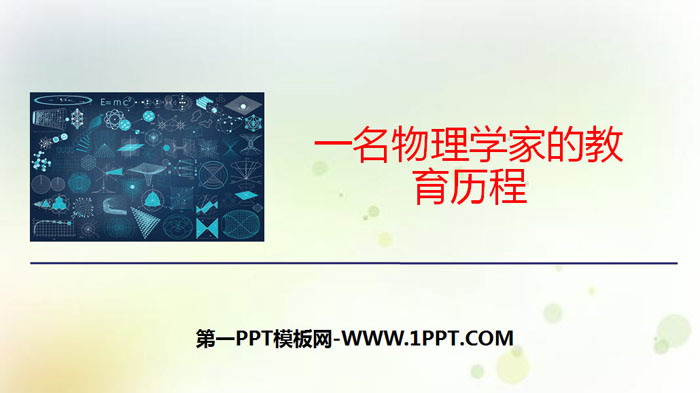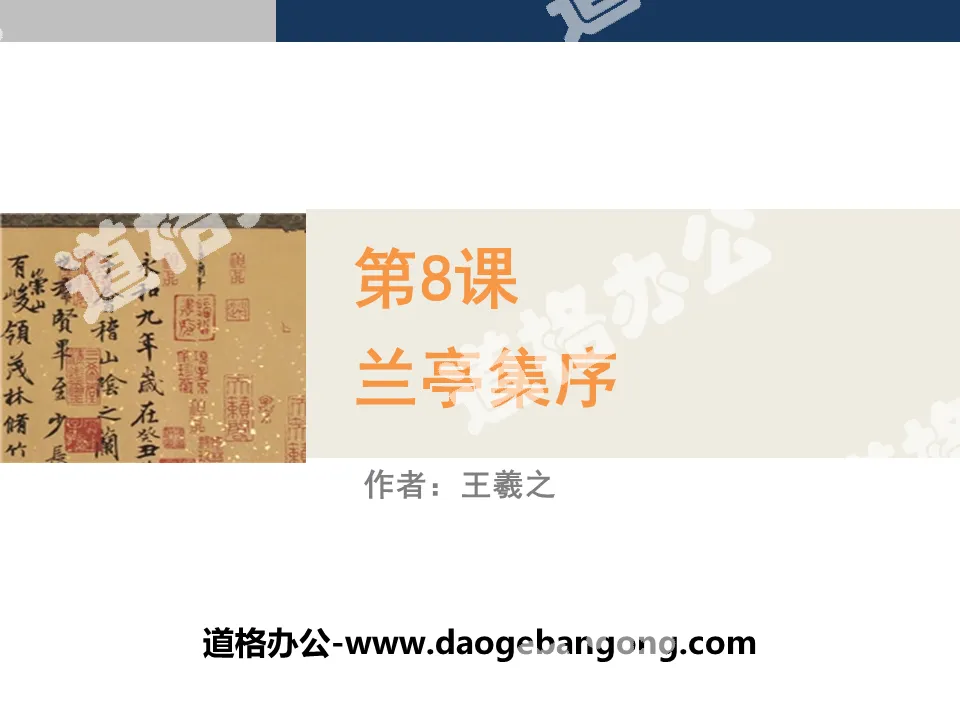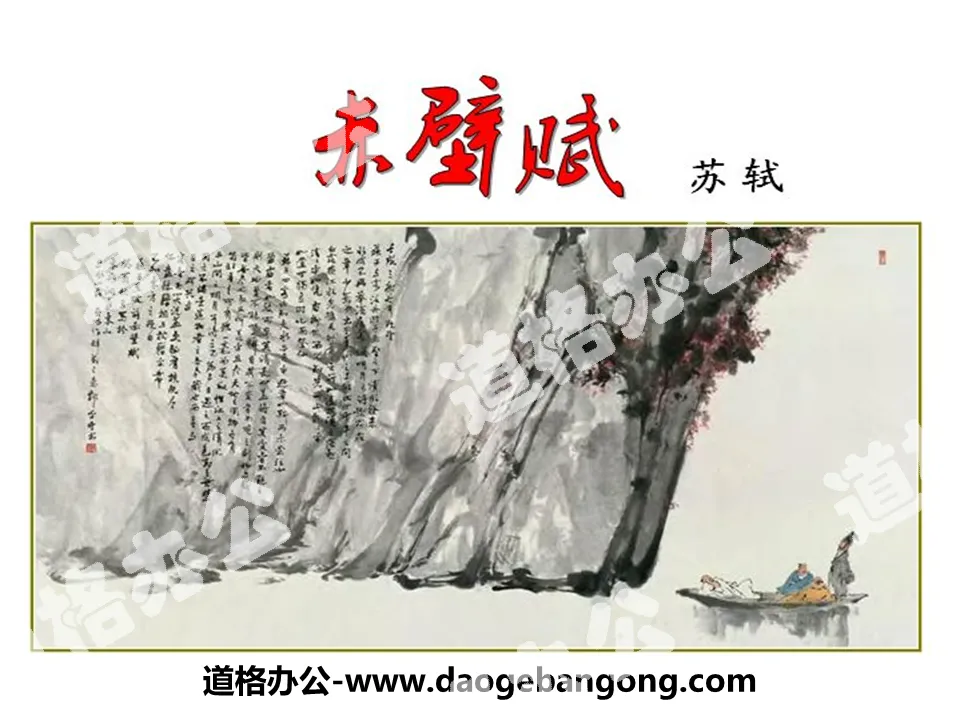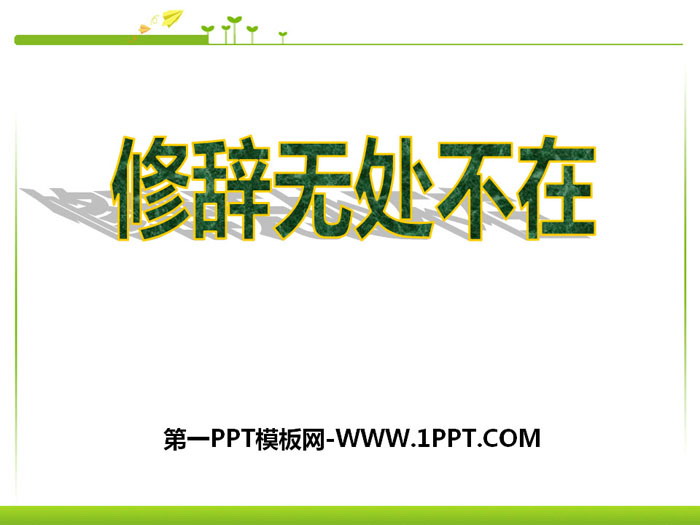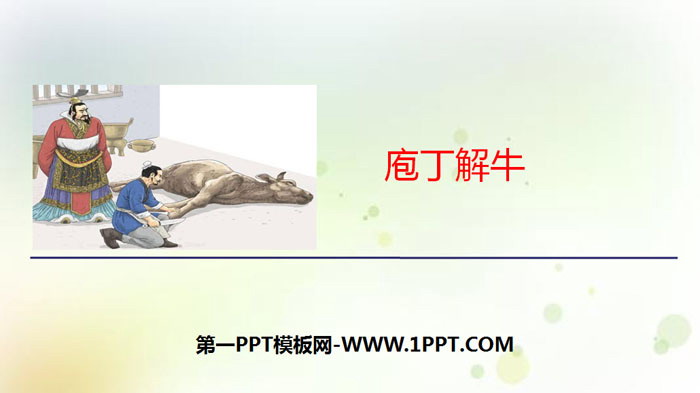
| Category | Format | Size |
|---|---|---|
| People's Education Press High School Chinese Compulsory Course 2 | pptx | 6 MB |
Description
"Li Sao" PPT teaching courseware
Part One: Morning Reading Guide
There was a poet, by the water
For thousands of years, Qu Yuan, as a poet, has presented the charm of individual life, monopolized the glory and spiritual space of a nation's traditional festivals, and has been so grandly commemorated by the people. This is unique in Chinese history. This broad and profound cultural landscape made Qu Yuan a heroic epic and flutter into a bright red flag in the minds of descendants of the Yan and Huang Dynasties throughout the ages. Miluo River, this nameless river, became as famous as the Yangtze and Yellow Rivers because of Qu Yuan.
Qu Yuan was a poet who was born and lived for his motherland. Most of his life was spent in the sigh of abandonment and helplessness. His poems were not written with ink, but smeared with blood and tears. Exile was unfortunate for Qu Yuan, but it was a great blessing for the ancient people of Sanxiang and Four Rivers. Just between Xiangyuan and Xiangyuan, this great poet left outstanding poems such as "Li Sao", "Nine Songs" and "The Fisherman". When we read his poems today, we always clearly hear a patriotic minister crying and confessing his love over and over again, but we can never forget his image of him in the wilderness at sunset, overlooking the water and looking into the distance. People are mortal, but what kind of charm should people have who can still be remembered by the people as a traditional festival for more than two thousand years after their death?
Li Sao PPT, Part 2: Preview before class
1. Learning objectives
1. Understand the formal characteristics of "Sao style poetry", grasp key words, clear verses, and cultivate students' ability to initially appreciate and evaluate ancient poetry.
2. Understand the characteristics of Romantic poetry. Understand the effect of using symbolic techniques in poetry.
3. By appreciating the beautiful verses of "Li Sao", one can learn from Qu Yuan's noble character of pursuing beautiful politics and caring about the country and the people.
2. Author’s connection
The founder of Chinese romantic literature - Qu Yuan
Qu Yuan (340 BC - 278 BC) was named Ping, also named Lingjun. A native of Chu State during the Warring States Period, he was a native of Danyang (now Zigui, Hubei Province). Qu Yuan was born into a noble family of Chu State and had the same ancestor as King Huai. He is knowledgeable and well versed in astronomy, geography, rituals and music systems. He was "well-read and strong-willed, knowledgeable in managing chaos, and skilled in rhetoric." At first, he gained the trust of King Huai of Chu. "When he entered, he discussed state affairs with the king and issued orders; when he went out, he received guests and dealt with the princes."
In terms of domestic affairs, he advocated "amending laws", "appointing talents and talents", and implementing "beautiful policies" to make the country prosperous and strong; in terms of diplomacy, he had a far-sighted vision and advocated confrontation with the powerful Qin. Later, he was framed by villains and was exiled twice. Finally, he threw himself into the Miluo River and died. Qu Yuan is the founder and representative writer of the "Chu Ci" style. Representative works include "Li Sao", "Tianwen", "Nine Songs", "Nine Chapters", "The Soul Calling", etc. The first great romantic poet in the history of Chinese literature, the greatest patriotic poet, and a world cultural celebrity. In 1953, the World Peace Council listed Qu Yuan as a "World Cultural Celebrity" and called on people all over the world to commemorate him.
3. Background exploration
"Li Sao" was written "sorrowful and meditative"
Qu Yuan experienced three periods in his life: King Wei of Chu, King Huai, and King of Qingxiang, and he was mainly active during the period of King Huai of Chu. This period was the eve of China's imminent unification, "horizontally, it was the Emperor of Qin, and vertically, it was the King of Chu." Qu Yuan was born into a noble family, and he was good at managing chaos and adept at rhetoric. Therefore, he was deeply favored by King Huai of Chu in his early years. In order to realize the great cause of the unification of Chu State, Qu Yuan actively assisted King Huai to reform and strengthen himself internally, and firmly advocated uniting Qi to resist Qin externally, which made the Chu State become rich and powerful, and powerful among the princes. However, due to sharp conflicts between Qu Yuan and the decadent aristocratic group of Chu state in domestic and foreign affairs, he was later framed by a small group and alienated by King Huai of Chu. In the spring of the thirty-ninth year of King Huai of Chu (300 BC), Qu Yuan was excluded and exiled to northern Han Dynasty. "Li Sao" was created here. "Li Sao" is a gripping political lyric poem written with blood and tears after his political defeat.
4. Stylistic knowledge
Chu Ci style
In the middle and late Warring States Period, poets such as Qu Yuan of Chu State absorbed the essence of folk songs and integrated them with ancient myths and legends to create a new style of poetry - Chu Ci style. It is characterized by grand structure, rich imagination, flexible sentence structure, and the frequent use of the word "xi" to aid language momentum. Qu Yuan, Song Yu and others are representative writers of this poetry style. Since "Li Sao" is the most representative work of this poetry style, this new style of poetry is also called "Sao Style".
About "Li Sao"
"Li Sao" is Qu Yuan's most magnificent poem and the longest romantic political lyric in the history of ancient Chinese poetry. It is an epitome of Qu Yuan's lifelong pursuit of patriotic truth and his endless struggle for it. It is a romantic masterpiece that "can rival the sun and the moon for glory." The whole poem has a total of 373 lines and 2,477 words. The poet begins by narrating his life experience, moral character, and ideals, and expresses the depression and contradiction of being slandered and persecuted. He denounces the fatuousness of the king of Chu, the rampant gangs, and the deterioration of the government. It shows that the poet adheres to the ideal of "beautiful government" and criticizes the dark reality. The fighting spirit of not collaborating with evil forces and the unswerving patriotic enthusiasm until death. "Li Sao" and "The Book of Songs" are both known as "Feng Sao" in the history of literature. They are the two major sources of Chinese classical poetry and have a profound impact on later generations.
Li Sao PPT, the third part: classroom exploration
1. Collaborative exploration
1. "I took a long breath to cover my tears, mourning the hardships of the people's lives." What kind of ideological realm does this sentence reflect?
Answer: A patriotic poet who cares about the fate of the country and the people's livelihood is where his heart lies. But in that era, people's life was difficult and miserable, which could not help but make the poet lament and feel sad. As a feudal scholar-official who had been devalued several times, he could only sigh up to the sky, cover his face and cry.
2. How should the word "regret" in the sentence "Regret" be understood more appropriately? Does it contradict the "no regrets" in "Although he died nine times, he still has no regrets"? Why?
Answer: The first stanza is about the poet who was framed by villains because he went straight on the right path and did not follow the popular trend. The king did not distinguish between right and wrong and alienated him. Although he suffered heavy blows from many sides, he remained determined and never flinched. In the second stanza, it is written that the poet intends to retire, be noble and self-sufficient, and no longer be aggressive in political activities and seek change. Staying away from politics does not mean giving up ethics, so there is no contradiction.
3. What kind of lyrical protagonist image is created in the poem "Li Sao"?
Answer: "Li Sao" creates for us the image of a lyrical protagonist who is concerned about the country and the people, walks on the right path, and devotes himself to his ideals. First of all, he has outstanding external image characteristics. "The crown of Gao Yu is precarious, and the Lu Li of Yu Pei is long." "Make lotus flowers to make clothes, and gather hibiscus to make clothes." Even if the word "Qu Yuan" is not written on many of Qu Yuan's portraits, people can still recognize him at a glance because they all rely on this characteristic description in the poem. Secondly, he has a distinctive ideological character. First, he is a progressive political reformer who advocates the rule of law ("rules" and "shengmo") and the promotion of talents.
Second, he advocated good governance, paying attention to the interests of the people and the role of the people ("Sorrow for the hardships of the people's livelihood" and "The spiritual practice of resentment is so overwhelming that it never checks the minds of the people"), and opposed the licentiousness and tyranny of the rulers and the pursuit of self-interest by the ministers. . Third, he pursues the truth and is unyielding ("I have a good heart, but I still have no regrets even though I died nine times", "Although I understand that I have not changed, I have no heart to punish"). This image is a concentrated expression of the spirit of the Chinese nation. It has set an example of character and behavior for countless people with lofty ideals over the past two thousand years, and also given them strength.
2. Summary
A closer look at the theme
"Li Sao" is Qu Yuan's representative work. It is a poem written by the author when he encountered sorrow. It is a gripping work expressing his concern for the country, written with blood and tears after his political failure. This article is an excerpt of part of it. The author first explained the reason for being demoted, and then expressed his unwillingness to collude with the treacherous people of the day. Then the author showed his noble sentiments of pursuing "beautiful politics" and surviving without regrets, expressing the poet's concern for the country and the people. , the patriotic spirit of devotion to ideals.
Li Sao PPT, the fourth part: expansion and extension
1. Variety of materials
1. loyalty
For his loyalty to his country, he never regretted it even though he died nine times. He wore fragrant grass and wildflower as his clothes. It is a pity that under the oppression of the treacherous villain and the fatuous king, the ideal of "beautiful government" turned into a loyal soul on the Miluo River, floating on the fifth day of the fifth lunar month every year. However, "The road is too long to be repaired, so I will search up and down." "I will take a long breath to cover my tears, and mourn the hardships of the people's lives." The poet who keeps searching, the poet who keeps pursuing, the poet who keeps cursing the evil in the world, looks haggard The poet who describes being haggard and often singing long songs by the river while weeping and composing poems with tears has crossed the vastness of time and entered our hearts with the persistence of "doing it even though he knew it was impossible". As a result, Qu Yuan has become a symbol of our Chinese culture and a shining spiritual monument that we can still see no matter how far apart the era is.
2. Perseverance
Qu Yuan's life was a tragic life. He not only had the ambition to "preserve the emperor and rejuvenate the country", but also had the ability to govern the country and deal with chaos. He was "well-read and strong-willed, knowledgeable in managing chaos, and skilled in rhetoric." He had the ideal of "beautiful government" and tried to improve the situation of Chu State. However, he was besieged by dark forces, which triggered a tragic conflict. The most touching thing is that Qu Yuan has always been the conscious bearer of his own tragic fate. He had enough estimates of the personal consequences of persisting in the struggle, but he did not hesitate and still consciously shouldered the responsibility: "I knew that Jianjian was in trouble, so I couldn't bear to give up." "I would rather die in exile, but I can't bear it." This is the attitude!" "Although I understand that I haven't changed, how can I be punished?" He knew that if he persisted, he would suffer misfortune, but in order to stick to his principles, he still persisted in fighting to the end, and thus endured great pain. Ultimately leading to a great tragedy in life.
3. choice of mind
Life is about showing yourself on a stage, and every detail of your movements must be carefully considered. With every gesture, you are choosing, joy or sadness? There are too many crossroads in the journey of life, and there are too many choices. Standing at the intersection, I listen to the whispers of my heart.
On the bank of the Miluo River, Qu Yuan in plain clothes leaped from the boulder. A loyal minister of a generation, he chose to die to prove his loyalty to the Chu State. In front of him was the coercion and inducement of the Queen of the South, and with his talent, it was not difficult for him to gain fame in other countries. "When the whole world is turbulent, I am alone pure; when everyone is drunk, I am alone sober." He is strong-willed and strong-willed. Between glory and wealth and the nation, he chose the latter. Every wave in the Miluo River is a witness.
2. Technique Learning
Metaphors and Symbolism
Metaphors and symbolic techniques are widely used in "Li Sao". Metaphors are rich, complex, and interconnected, creating groups of images rich in symbolic color. For example, "hui", "lan" and "momei" are used to describe one's own virtue; "spiritual cultivation" is used to describe the king and his heart; "women" is used to describe gang rape; "first submission" is used to describe the original ambition; "Bird of prey" is a metaphor for the poet's staunchness, and "lotus" and "hibiscus" are used to express the poet's beautiful spiritual realm. These metaphors leave a rich imagination to people and are full of strong romantic atmosphere.
Borrowing a specific image to imply a specific person or event to express sincere feelings and profound meanings. This artistic expression technique of using objects to represent things is called symbolism. The performance effect of the symbol is: it has profound meaning, can enrich people's associations, is thought-provoking, and gives people a sense of infinite artistic conception; it can give people a concise and vivid sense of reality, and can express sincere feelings.
3. Test center links
Grasp the "poetry eye" to understand poetry
In "Li Sao", "There are still good things in my heart, and I still have no regrets even if I die nine times." This is a poem in which the poet directly expresses his heart and expresses his aspirations. He writes about his pursuit of beautiful virtues, which he will never change until his death. Similar lines in the poem include "I would rather die in exile, I can't bear to be in this state", "Fu Qingbai wants to die straight, to consolidate the kindness of the previous saints", "I didn't know that he was already gone, I still love him and believe in him." "Wait, these sentences are poetic eyes. Using these sentences as clues, we can understand the poet's thoughts and feelings.
Poetry has a "poetry eye" and words have a "word eye". The "poetry eye" and "word eye" here are sometimes a concise and expressive word, and sometimes they are keywords and key sentences that convey the main idea. Poetry eyes are usually verbs or adjectives. To analyze poetry is to grasp the most concise and expressive verbs or adjectives in the poems and taste them to see their role in deepening the artistic conception of the poem and conveying the poet's emotions.
"Poetry eyes" are divided into "eyes in sentences" and "eyes in articles". The so-called "eye in the sentence" refers to one or two key words that can make a poem vivid and even "alive". "The sound of one word can make the whole sentence strange." The so-called "eye in the article" is often the main theme of the whole poem. Some of the "eye in the article" are words, phrases, and some are sentences.
[Method Instructions]
1. Explicit type. Distinguish whether the poetic eye is "the eye in the sentence" or "the eye in the article".
2. Analysis role. "Eye in a sentence" usually requires explaining the meaning of the word "eye in the sentence" first, and then putting it into the poem to describe the scene. If it involves rhetoric or other expression techniques, it should also be pointed out and analyzed, and finally the "eye in the sentence" should be written. ” is effective in creating an atmosphere or expressing emotions. The "eye in the article" analysis method should focus more on the structure, content or theme of the entire article.
[Point-to-Point Training] Please answer question 12 in the "Synchronization Exercise" according to the prompts here.
Keywords: Free download of PPT courseware for high school Chinese compulsory course 2 from the People's Education Press, download of Li Sao PPT, .PPT format;
For more information about the "Li Sao" PPT courseware, please click on the "Li Sao ppt" tab.
"Li Sao" PPT free courseware:
"Li Sao" PPT free courseware Part 1: Learning objectives 1. Appreciate important sentences and feel Qu Yuan's noble personality. 2. Appreciate the image of vanilla beauty in the poem and the use of empathy. ... ... ... Li Sao PPT, part 2: design ideas 1..
"Li Sao" PPT courseware download:
"Li Sao" PPT courseware download Part One: About the author Qu Yuan, the founder of Chinese romantic literature, Qu Yuan (approximately 340 BC - 278 BC), named Ping, courtesy name Yuan, and also courtesy name Lingjun. During the Warring States Period, he was a native of Chu State and a native of Danyang (now Zigui, Hubei Province). Qu Yuan was born into a noble family of Chu State,...
"Li Sao" PPT download:
The first part of "Li Sao" PPT download content: Pre-read the text first, learn the basic knowledge and language knowledge accumulation 1. Give the phonetic notation of the following colored words (1) Modify ( ) (6) 昘死 ( ) (2) Get rid of criticism ( ) (7) Fang Wan ( ) (3) Yan Wei ( ) (8) �庺 ( ) (4..
File Info
Update Time: 2024-06-28
This template belongs to Chinese courseware People's Education Press High School Chinese Compulsory Course 2 industry PPT template
"Li Sao" PPT teaching courseware Simple campus recruitment activity planning plan summary enterprise and institution recruitment publicity lecture PPT template is a general PPT template for business post competition provided by the manuscript PPT, simple campus recruitment activity planning plan summary enterprise and institution recruitment promotion Lecture PPT template, you can edit and modify the text and pictures in the source file by downloading the source file. If you want more exquisite business PPT templates, you can come to grid resource. Doug resource PPT, massive PPT template slide material download, we only make high-quality PPT templates!
Tips: If you open the template and feel that it is not suitable for all your needs, you can search for related content "Li Sao" PPT teaching courseware is enough.
How to use the Windows system template
Directly decompress the file and use it with office or wps
How to use the Mac system template
Directly decompress the file and use it Office or wps can be used
Related reading
For more detailed PPT-related tutorials and font tutorials, you can view: Click to see
How to create a high-quality technological sense PPT? 4 ways to share the bottom of the box
Notice
Do not download in WeChat, Zhihu, QQ, built-in browsers, please use mobile browsers to download! If you are a mobile phone user, please download it on your computer!
1. The manuscript PPT is only for study and reference, please delete it 24 hours after downloading.
2. If the resource involves your legitimate rights and interests, delete it immediately.
3. Contact information: service@daogebangong.com
"Li Sao" PPT teaching courseware, due to usage restrictions, it is only for personal study and reference use. For commercial use, please go to the relevant official website for authorization.
(Personal non-commercial use refers to the use of this font to complete the display of personal works, including but not limited to the design of personal papers, resumes, etc.)
Preview

